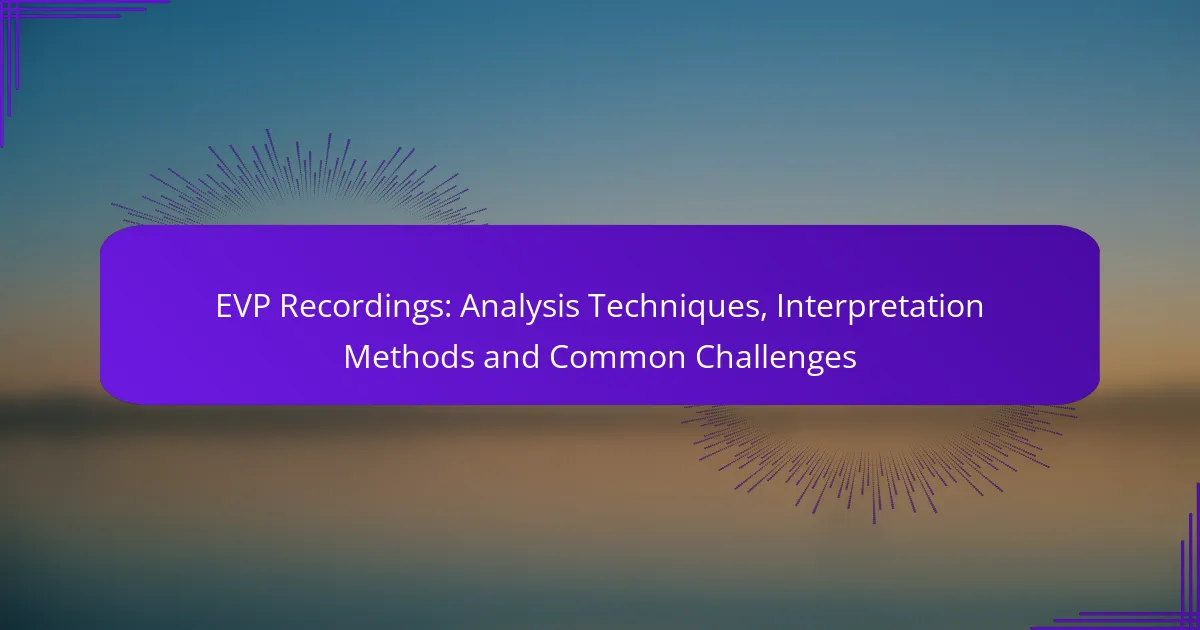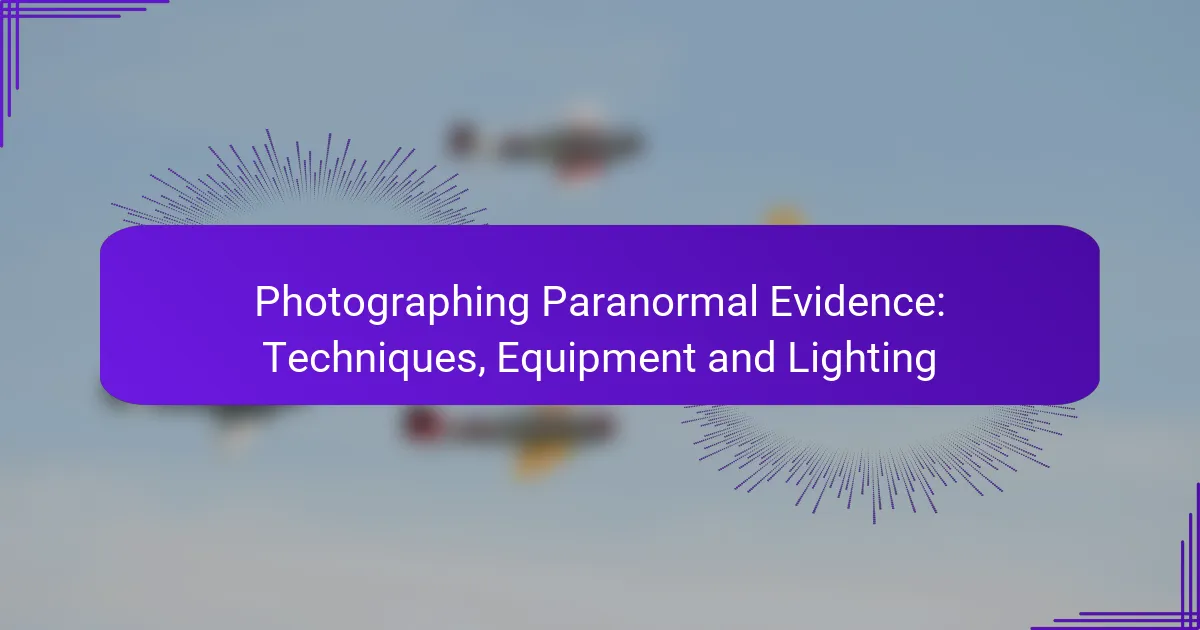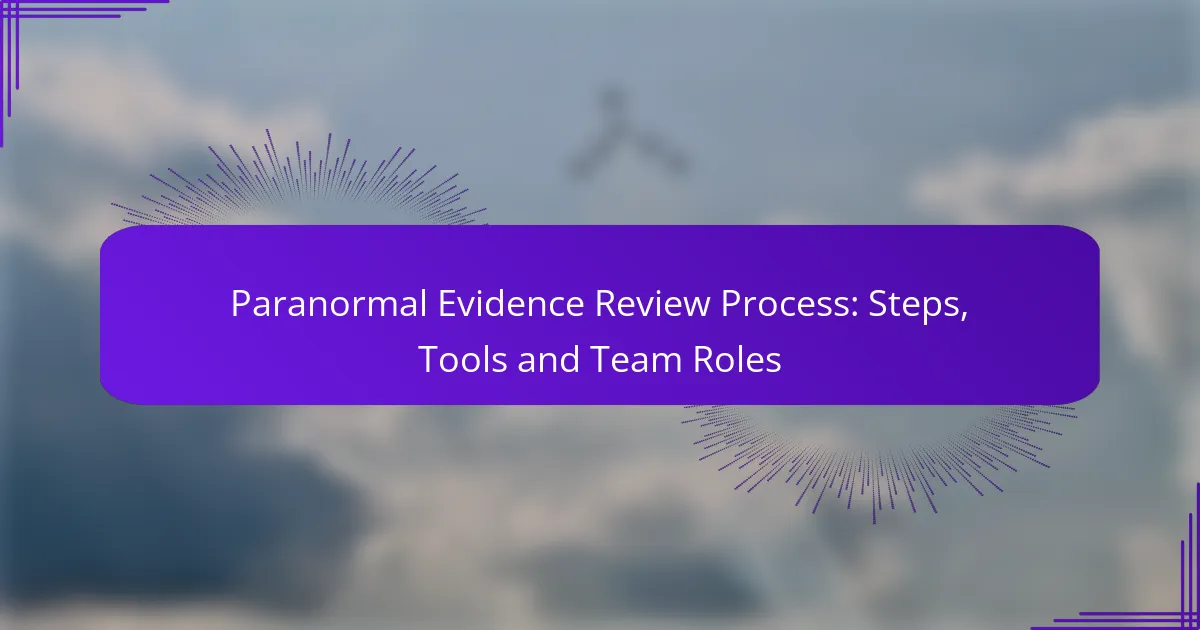EVP (Electronic Voice Phenomena) recordings present unique opportunities for exploration through various analysis techniques that enhance our understanding of the audio data. Effective interpretation requires careful consideration of context, the use of spectral analysis tools, and a comparison with known phenomena to differentiate genuine voices from background noise. However, analysts often encounter challenges such as noise contamination, subjective interpretations, and equipment limitations that can complicate the clarity and reliability of their findings.

What are the best analysis techniques for EVP recordings?
The best analysis techniques for EVP (Electronic Voice Phenomena) recordings include various methods that help in interpreting and understanding the audio data. These techniques range from time-domain analysis to advanced machine learning approaches, each offering unique insights and challenges.
Time-domain analysis
Time-domain analysis focuses on the waveform of the audio signal over time. This method allows researchers to observe amplitude variations and detect anomalies that may indicate the presence of EVP. It is often the first step in analyzing recordings, as it provides a visual representation of the sound wave.
When conducting time-domain analysis, pay attention to sudden spikes or unusual patterns in the waveform, as these can signify potential EVP occurrences. Tools like oscilloscopes or audio editing software can facilitate this analysis.
Frequency-domain analysis
Frequency-domain analysis involves transforming the audio signal to examine its frequency components. This technique helps identify specific frequencies where EVP might be present, often using tools like Fast Fourier Transform (FFT). By analyzing the frequency spectrum, researchers can isolate sounds that are not typically audible.
Consider using frequency-domain analysis to filter out background noise and enhance the clarity of potential EVP signals. This method can reveal subtle audio features that time-domain analysis may overlook.
Wavelet transform
The wavelet transform is a sophisticated technique that provides a multi-resolution analysis of the audio signal. Unlike traditional Fourier analysis, wavelet transforms can capture transient features in the signal, making them particularly useful for detecting short-lived EVP events.
When applying wavelet transforms, choose appropriate wavelet functions based on the characteristics of the EVP recordings. This method can help reveal hidden patterns and improve the overall interpretation of the data.
Statistical analysis methods
Statistical analysis methods involve applying mathematical techniques to quantify the characteristics of EVP recordings. This can include measures like signal-to-noise ratio (SNR) and variance, which help assess the quality and reliability of the findings.
Utilizing statistical methods can provide a more objective basis for interpreting EVP results. Be cautious of over-relying on statistics without considering the qualitative aspects of the recordings, as context is crucial in EVP analysis.
Machine learning approaches
Machine learning approaches leverage algorithms to identify patterns and classify EVP recordings automatically. These techniques can analyze large datasets more efficiently, helping researchers uncover subtle trends that may not be evident through manual analysis.
When implementing machine learning, ensure you have a well-labeled dataset for training the models. This approach can significantly enhance the accuracy of EVP detection, but it requires careful consideration of algorithm selection and validation methods to avoid misinterpretation of results.

How to interpret EVP recordings effectively?
To interpret EVP recordings effectively, one must analyze the context, compare findings with known phenomena, and utilize spectral analysis tools. These methods help in distinguishing genuine electronic voice phenomena from background noise and other audio artifacts.
Contextual analysis
Contextual analysis involves examining the circumstances surrounding the EVP recording, such as the location, time, and any relevant events. Understanding the environment can provide insights into the authenticity of the recording and the potential sources of the voices captured.
Consider factors like ambient noise, equipment used, and the presence of other individuals during the recording. Documenting these elements can help in assessing the credibility of the EVP and determining if the sounds align with the expected phenomena.
Comparative analysis with known phenomena
Comparative analysis entails matching the EVP recordings with established audio phenomena, such as natural sounds or known voice patterns. This process helps identify whether the recording contains recognizable speech or if it falls into the realm of random noise.
Utilizing a database of known EVPs can assist in this comparison. By analyzing similarities and differences, investigators can better understand the nature of the recording and its potential significance.
Use of spectral analysis tools
Spectral analysis tools are essential for visualizing and examining the frequency components of EVP recordings. These tools can reveal patterns that are not audible to the human ear, helping to differentiate between genuine voices and background noise.
Common tools include audio editing software with spectral analysis capabilities. When using these tools, focus on identifying distinct frequency spikes that may indicate voice activity. Be cautious of over-interpreting results, as artifacts can sometimes mimic genuine EVP signatures.

What common challenges arise in EVP recording analysis?
EVP recording analysis often faces several challenges that can hinder the clarity and reliability of results. Key issues include noise contamination, subjectivity in interpretation, equipment limitations, and environmental factors that can affect recordings.
Noise contamination
Noise contamination occurs when unwanted sounds interfere with the clarity of EVP recordings. Common sources of noise include electronic interference, background chatter, and environmental sounds like wind or traffic. To minimize this, record in quiet locations and use high-quality equipment designed to filter out background noise.
Using directional microphones can help focus on specific sounds while reducing ambient noise. Additionally, consider conducting recordings during times when external noise is at its lowest, such as late at night or early in the morning.
Subjectivity in interpretation
Subjectivity in interpretation is a significant challenge in EVP analysis, as different listeners may perceive the same recording in various ways. Personal beliefs, experiences, and expectations can influence how one interprets the sounds captured. To mitigate this, it is helpful to have multiple analysts review the recordings independently.
Establishing a standardized set of criteria for interpretation can also aid in reducing bias. Documenting interpretations and discussing them in a group setting can provide diverse perspectives and lead to more objective conclusions.
Equipment limitations
Equipment limitations can significantly impact the quality of EVP recordings. Low-quality microphones or recorders may not capture subtle sounds, leading to missed evidence. Investing in good-quality recording devices and accessories, such as windshields and pop filters, can enhance sound clarity.
Regularly calibrating and maintaining equipment is essential to ensure optimal performance. Be aware of the specifications of your devices; for instance, some recorders may have a limited frequency response that could affect the capture of certain sounds.
Environmental factors
Environmental factors, such as temperature, humidity, and electromagnetic fields, can influence EVP recordings. High humidity can affect sound transmission, while electromagnetic interference from nearby devices can distort recordings. Conducting EVP sessions in controlled environments can help minimize these effects.
Consider using portable soundproofing materials or conducting recordings in isolated areas to reduce external influences. Monitoring environmental conditions during recordings can also provide context for any anomalies detected in the audio.

What prerequisites are needed for effective EVP analysis?
Effective EVP analysis requires a solid understanding of audio engineering principles and familiarity with EVP recording equipment. These prerequisites help ensure accurate interpretation and minimize common errors during analysis.
Understanding audio engineering principles
A foundational grasp of audio engineering principles is essential for EVP analysis. This includes knowledge of sound waves, frequency ranges, and how audio signals are captured and processed. Understanding concepts like sampling rates and bit depth can significantly impact the quality of recordings.
For instance, using a sampling rate of at least 44.1 kHz is recommended to capture a wide range of frequencies. This ensures that subtle sounds, which may be crucial for EVP analysis, are not lost. Additionally, familiarity with sound editing software can aid in isolating and enhancing EVP recordings.
Familiarity with EVP recording equipment
Being well-versed in the specific equipment used for EVP recording is crucial. This includes knowing how to operate digital voice recorders, microphones, and other audio capture devices. Each piece of equipment has its own settings and features that can affect recording quality.
For example, using a high-quality microphone with a low self-noise level can improve the clarity of captured sounds. It’s also important to understand the environment where recordings are made, as background noise can interfere with the clarity of EVPs. Practicing with different setups and conditions can help refine your skills and improve results.

What tools are recommended for EVP recording analysis?
For effective EVP recording analysis, tools like Audacity, SpectraPlus, and Adobe Audition are highly recommended. Each tool offers unique features that cater to different aspects of audio editing and spectral analysis, making them suitable for various levels of expertise.
Audacity for audio editing
Audacity is a free, open-source audio editing software that is user-friendly and widely used for EVP analysis. It allows users to record, edit, and manipulate audio tracks with features such as noise reduction, equalization, and pitch adjustment.
To get started, simply import your EVP recordings into Audacity, apply effects to enhance clarity, and export the final product in various formats. Be cautious of over-processing audio, as this can distort the original recording.
SpectraPlus for spectral analysis
SpectraPlus is a specialized software for spectral analysis that provides detailed visual representations of audio frequencies. This tool is particularly useful for identifying anomalies and patterns in EVP recordings that may not be audible to the human ear.
When using SpectraPlus, focus on the spectrogram and frequency analysis features to pinpoint unusual sounds. Ensure that you are familiar with the software’s interface to maximize its potential in revealing hidden audio details.
Adobe Audition for advanced editing
Adobe Audition is a professional-grade audio editing software that offers advanced features for EVP analysis, including multitrack editing, noise reduction, and spectral frequency display. This tool is ideal for users looking to perform in-depth analysis and high-quality editing.
Utilize Adobe Audition’s powerful tools to clean up recordings and enhance sound quality. However, be aware that its complexity may require a learning curve, so consider starting with simpler tasks before diving into advanced features.



